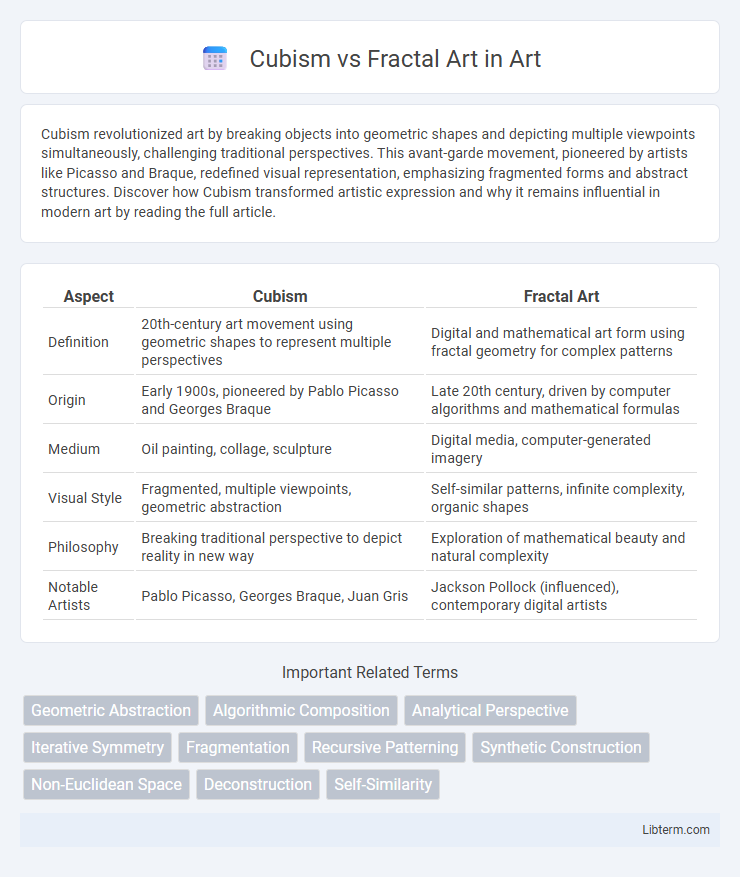Cubism revolutionized art by breaking objects into geometric shapes and depicting multiple viewpoints simultaneously, challenging traditional perspectives. This avant-garde movement, pioneered by artists like Picasso and Braque, redefined visual representation, emphasizing fragmented forms and abstract structures. Discover how Cubism transformed artistic expression and why it remains influential in modern art by reading the full article.
Table of Comparison
| Aspect | Cubism | Fractal Art |
|---|---|---|
| Definition | 20th-century art movement using geometric shapes to represent multiple perspectives | Digital and mathematical art form using fractal geometry for complex patterns |
| Origin | Early 1900s, pioneered by Pablo Picasso and Georges Braque | Late 20th century, driven by computer algorithms and mathematical formulas |
| Medium | Oil painting, collage, sculpture | Digital media, computer-generated imagery |
| Visual Style | Fragmented, multiple viewpoints, geometric abstraction | Self-similar patterns, infinite complexity, organic shapes |
| Philosophy | Breaking traditional perspective to depict reality in new way | Exploration of mathematical beauty and natural complexity |
| Notable Artists | Pablo Picasso, Georges Braque, Juan Gris | Jackson Pollock (influenced), contemporary digital artists |
Defining Cubism: Origins and Key Concepts
Cubism, pioneered by Pablo Picasso and Georges Braque in the early 20th century, is an artistic movement characterized by fragmented and abstracted forms that depict multiple perspectives simultaneously. Key concepts include the deconstruction of objects into geometric shapes and the exploration of spatial relationships, challenging traditional single-point perspective. Originating in Paris around 1907, Cubism laid the foundation for various modern art movements by emphasizing analytical composition and conceptual depth.
Understanding Fractal Art: Foundations and Methodologies
Fractal art is a digital art form rooted in mathematical algorithms that generate complex, self-similar patterns reflecting natural phenomena like coastlines and snowflakes. Unlike Cubism, which deconstructs objects into geometric shapes to depict multiple perspectives, fractal art emphasizes iterative processes and infinite detail through recursive formulas. Methodologies in fractal art often involve software tools that render fractal sets, such as the Mandelbrot or Julia sets, transforming abstract mathematical concepts into visually captivating images.
Historical Evolution: From Cubism to Digital Fractals
Cubism emerged in the early 20th century, pioneered by Pablo Picasso and Georges Braque, challenging traditional perspectives through fragmented and abstracted forms. This avant-garde movement laid the groundwork for exploring complex geometries, which digital technology later expanded into fractal art during the late 20th century. Fractal art leverages algorithmic processes to create infinitely intricate and self-similar patterns, representing a significant evolution from Cubism's hand-painted abstractions to computer-generated visualizations.
Visual Language: Geometric Forms in Cubism and Fractal Art
Cubism employs fragmented geometric shapes such as cubes, cones, and spheres to deconstruct and represent multiple perspectives simultaneously, creating a multi-faceted visual language. Fractal art utilizes recursive mathematical patterns and self-similar geometric forms, generating intricate, infinitely complex visuals that emphasize natural symmetry and scaling. Both art forms prioritize geometry but diverge in structure: Cubism emphasizes analytical abstraction of objects, while fractal art explores algorithmic complexity and organic growth patterns.
Techniques and Tools: Paintbrushes vs Algorithms
Cubism employs traditional paintbrush techniques to break down subjects into geometric shapes and multiple perspectives, emphasizing manual brushstrokes and texture variations. Fractal art relies on sophisticated algorithms and mathematical formulas to generate intricate, self-similar patterns and infinite detail, often created with specialized software like Apophysis or Mandelbulb3D. The contrast between Cubism's tactile, handcrafted approach and fractal art's algorithm-driven precision highlights the evolution from manual artistry to digital mathematical creation.
Notable Artists: Pioneers of Cubism and Fractal Art
Pablo Picasso and Georges Braque are notable pioneers of Cubism, revolutionizing art with fragmented perspectives and geometric forms. In contrast, fractal art pioneers include Benoit Mandelbrot, whose mathematical discoveries inspired digital artists like Kerry Mitchell and Jackson Pollock's influence in visual complexity. Both movements emphasize abstract representation but diverge in technique--Cubism's analytic approach versus fractal art's algorithmic creativity.
Perception and Interpretation: Viewer Experience Compared
Cubism deconstructs objects into geometric shapes, challenging traditional perception by presenting multiple perspectives simultaneously, which requires viewers to actively reconstruct the image mentally. Fractal art, based on mathematical patterns and infinite scaling, evokes a sense of organic complexity and continuity, often inducing a meditative or awe-inspired interpretive experience. Both art forms engage viewers intellectually, but Cubism emphasizes analytical reconstruction, while fractal art emphasizes immersive visual exploration.
The Role of Mathematics in Both Art Movements
Cubism utilizes geometric principles like Euclidean shapes and spatial fragmentation to deconstruct objects into multiple viewpoints, reflecting a mathematical approach to perspective and form. Fractal art, based on complex algorithms and recursive patterns, harnesses fractal geometry to create intricate, self-similar structures that extend infinitely at different scales. Both movements embed mathematical concepts deeply into their creative processes, with Cubism emphasizing abstract geometry and Fractal art exploring nonlinear dynamics.
Cultural Impact: Influence on Modern and Contemporary Art
Cubism revolutionized 20th-century art by deconstructing objects into geometric forms, profoundly influencing modernist movements such as Futurism and Abstract Art. Fractal art, emerging with digital technology, introduced complex mathematical patterns that reshaped contemporary visual aesthetics and inspired innovations in digital media and design. Both movements challenged traditional representation, shaping cultural narratives around perception, abstraction, and the interplay between art and science in modern and contemporary art.
Cubism vs Fractal Art: Future Directions and Fusion
Cubism emphasizes deconstructed geometric shapes and multiple perspectives, while fractal art explores infinite patterns through mathematical algorithms, offering unique visual complexity. The future of Cubism versus fractal art lies in integrating algorithmic fractal generation with Cubism's fragmented viewpoints to produce dynamic, multi-dimensional artworks. Emerging technologies like AI-driven fractal manipulation combined with Cubist compositional principles could revolutionize art fusion, advancing both styles toward immersive digital experiences.
Cubism Infographic

 libterm.com
libterm.com